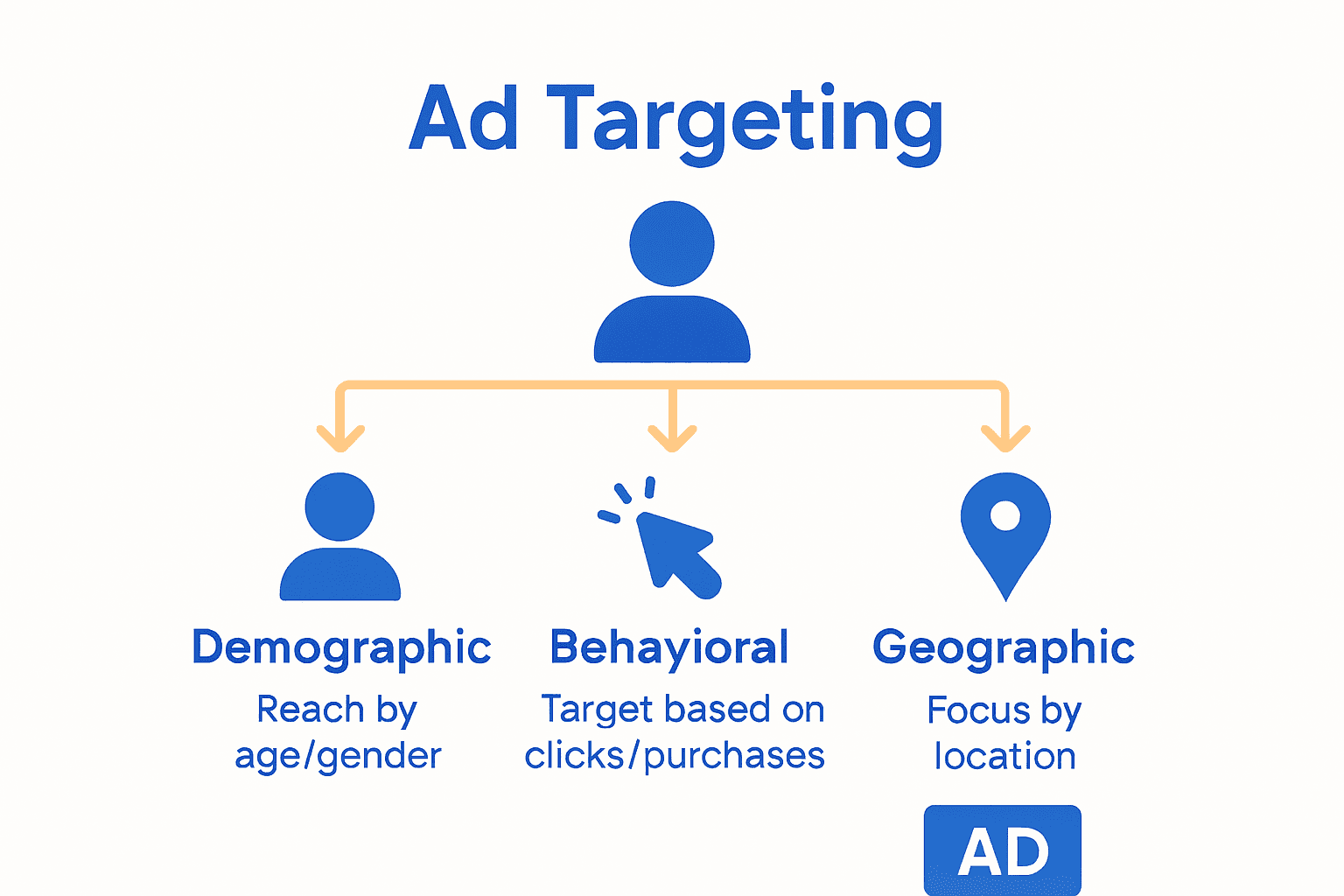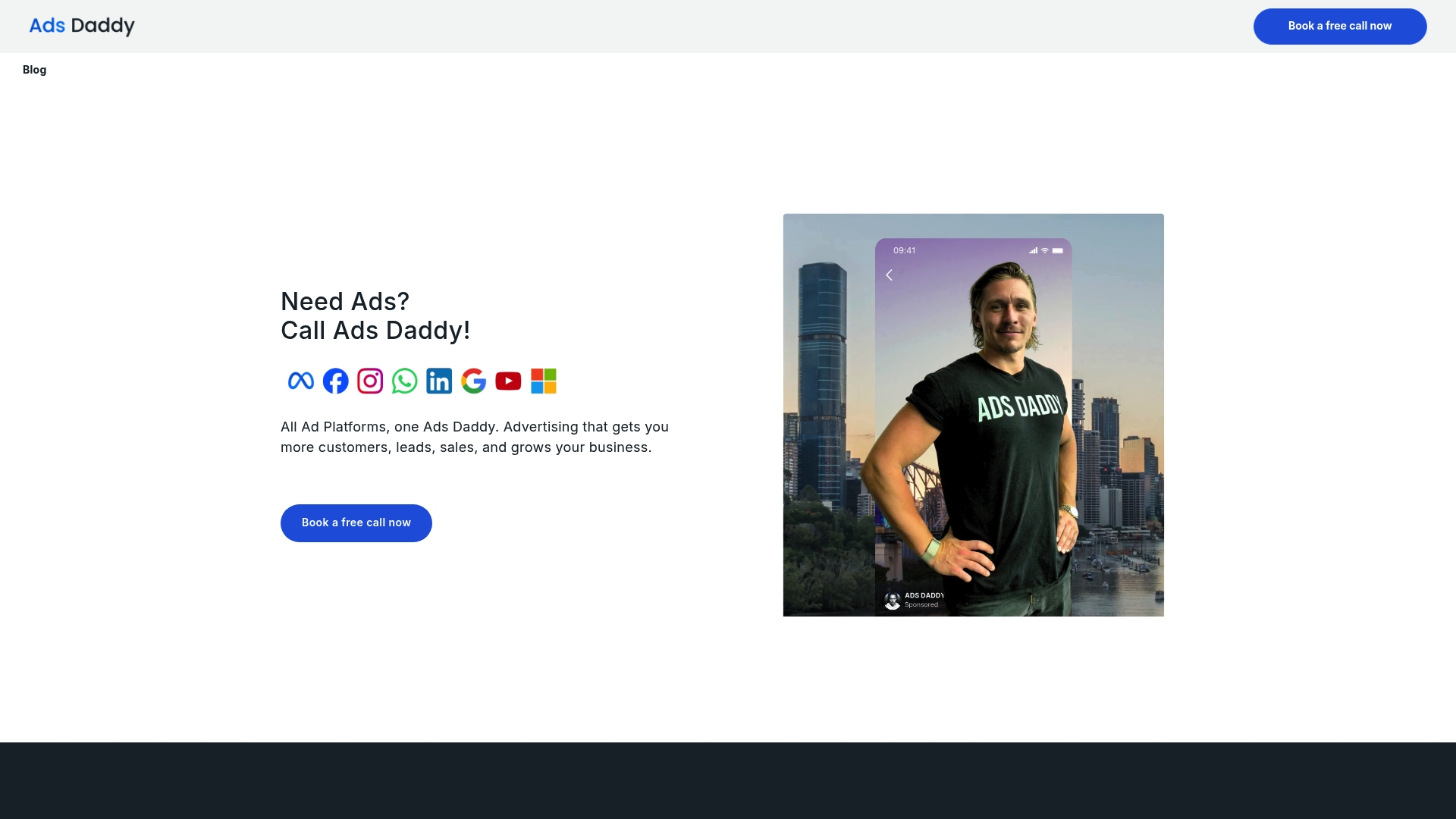Did you know that businesses using precise ad targeting can see up to a 200 percent increase in ROI compared to generic campaigns? Today, online ads follow users everywhere, but most people tune out irrelevant messages. Effective ad targeting changes that by matching the right ads with the right audience at the perfect moment. Understanding how this works can make your digital marketing budget work harder while connecting your brand to those who actually care.
Key Takeaways
| Point | Details |
|---|---|
| Precision Matters | Ad targeting focuses on delivering relevant messages to specific audience segments, enhancing marketing efficiency. |
| Diverse Targeting Strategies | Businesses can utilize demographic, geographic, behavioral, interest-based, and programmatic targeting approaches to reach their ideal customers. |
| Cost-Effectiveness | Targeted advertising reduces wasted spending by ensuring messages are delivered to genuinely interested audiences, improving conversion rates. |
| Common Pitfalls | Avoid targeting errors, such as neglecting audience segmentation and ineffective keyword selection, to enhance campaign performance. |
Table of Contents
- Defining Ad Targeting In Digital Advertising
- Types Of Ad Targeting Across Platforms
- How Ad Targeting Works: Data And Tools
- Real-World Benefits For Australian Businesses
- Common Mistakes And How To Avoid Them
Defining Ad Targeting in Digital Advertising
Targeted advertising represents a sophisticated approach to digital marketing that transforms how businesses connect with potential customers. Ad targeting allows companies to move beyond traditional blanket advertising strategies by delivering hyper-relevant messages to specific audience segments based on precise data points.
According to Shopify’s research, targeted advertising focuses on delivering ads to clearly defined audiences using customer data that reveals purchase intent. This approach encompasses multiple targeting strategies, including:
- Demographic targeting: Segmenting audiences by age, gender, income, education level
- Interest-based targeting: Reaching people based on their specific preferences and online behaviours
- Behavioural targeting: Tracking user actions like past purchases, website visits, and engagement patterns
- Geographic targeting: Focusing ads on people in specific locations or regions
Our comprehensive guide on Meta advertising reveals that effective ad targeting dramatically reduces wasted marketing spend by ensuring your message reaches the most relevant potential customers. By understanding and leveraging these targeting mechanisms, businesses can create more efficient, cost-effective advertising campaigns that speak directly to their ideal customer personas.

The core philosophy of ad targeting is precision. Rather than broadcasting a generic message to everyone, you’re strategically placing your advertisement in front of individuals most likely to be interested in your product or service. Think of it like using a laser-guided missile instead of a broad shotgun approach to marketing.
Types of Ad Targeting Across Platforms
Ad targeting has evolved into a sophisticated digital marketing strategy with multiple sophisticated approaches tailored to different platforms and audience segments. According to research from Shopify, modern digital advertising offers diverse targeting methods that allow businesses to reach precisely the right audience.
Core Targeting Strategies
Businesses can leverage several fundamental targeting approaches:
- Demographic Targeting: Segmenting audiences by age, gender, income, education
- Geographic Targeting: Focusing ads on specific locations or regions
- Behavioural Targeting: Tracking user actions like website visits and purchase history
- Interest-Based Targeting: Reaching people based on online preferences and engagement
- Programmatic Targeting: Automated ad placement using real-time bidding technologies
Platform-Specific Targeting Options
Learn how to get more clients using targeted ads, businesses can tap into platform-specific targeting tools. Major social platforms offer nuanced targeting capabilities:
- Facebook/Instagram: Custom Audiences, Lookalike Audiences, pixel-based remarketing
- LinkedIn: Professional demographic targeting, job role-based filtering
- YouTube: Interest and behavioural targeting based on watch history
- TikTok: Age and interest-based targeting for younger demographics
The key is understanding each platform’s unique targeting ecosystem and matching it with your specific business objectives. Precision matters more than reach in modern digital advertising.

Here’s a comparison of major targeting options on popular advertising platforms:
| Platform | Key Targeting Features | Best Use Cases |
|---|---|---|
| Facebook/Instagram | Custom & Lookalike Audiences Pixel remarketing |
Broad B2C Brand awareness |
| Professional demographics Job role-based filtering |
B2B marketing Professional services |
|
| YouTube | Interest targeting Behavioural based on watch history |
Video ads Younger digital audiences |
| TikTok | Age targeting Interest-based for young users |
Gen Z engagement Viral campaign reach |
How Ad Targeting Works: Data and Tools
Ad targeting operates through complex data collection and algorithmic processing that transforms raw user information into strategic advertising opportunities. Google’s AI developments are dramatically reshaping how these sophisticated targeting mechanisms function in real-time digital environments.
Data Collection Mechanisms
Advertising platforms gather user data through multiple channels:
- Browsing history: Tracking websites visited and pages viewed
- Social media interactions: Analyzing likes, shares, comments
- Purchase histories: Recording past transaction details
- Device information: Collecting data about user’s technology
- Location tracking: Understanding geographic movement patterns
Targeting Technologies
According to Shopify’s research, programmatic targeting represents a revolutionary approach where platform algorithms automatically identify and target user segments. This technique eliminates manual audience segmentation by using sophisticated machine learning models to find users similar to existing customers.
Real-time bidding (RTB) further amplifies this precision. As defined by Wikipedia, RTB enables instantaneous ad impression auctions, where advertisers competitively bid for displaying their advertisements. This means your ad can be selected, purchased, and displayed within milliseconds—creating an incredibly dynamic marketing ecosystem.
The magic happens through interconnected data points that transform anonymous online interactions into targeted advertising opportunities. By understanding user behaviors, preferences, and intent, businesses can deliver messages that feel personally crafted—not like generic, interruptive marketing noise.
Real-World Benefits for Australian Businesses
Ad targeting transforms how small and medium enterprises compete in the digital marketplace, offering unprecedented opportunities for growth and customer connection. For Australian businesses operating in a competitive landscape, these sophisticated marketing tools provide strategic advantages that were previously accessible only to large corporations with massive advertising budgets.
Cost-Effective Marketing Strategies
Targeted advertising delivers remarkable economic benefits by minimising wasted marketing spend. Instead of broadcasting messages to broad, uninterested audiences, businesses can now:
- Reduce advertising costs by focusing on genuinely interested potential customers
- Improve conversion rates through hyper-relevant messaging
- Optimise marketing budgets with precise audience segmentation
- Track real-time performance of advertising campaigns
- Adjust strategies instantly based on measurable data
Scaling Business Growth
Learn how to get more clients using targeted ads, Australian businesses can leverage these technologies to punch well above their weight. Whether you’re a local café in Melbourne, a tech startup in Sydney, or a regional service provider, ad targeting allows you to reach exactly the right customers at the right moment.
The true power lies in transforming generic advertising into personalised conversations. By understanding customer intent, preferences, and behaviors, businesses can craft messages that feel less like interruptions and more like helpful recommendations. This approach doesn’t just attract customers—it builds lasting relationships that drive sustainable business growth.
Common Mistakes and How to Avoid Them
Ad targeting requires precision and strategic thinking. Even experienced marketers can fall into traps that drain budgets and reduce campaign effectiveness. Understanding these common pitfalls is crucial for maintaining a robust digital advertising strategy.
Targeting and Audience Selection Errors
According to research from BrandCom, several critical mistakes can undermine your advertising efforts:
- Skipping negative keywords: Prevents irrelevant clicks that waste budget
- Using broad match without exclusions: Leads to untargeted traffic
- Neglecting audience segmentation: Reduces ad relevance and conversion potential
- Forgetting conversion tracking: Makes performance measurement impossible
Platform-Specific Targeting Mistakes
Our guide on getting more clients highlights platform-specific errors. On Meta platforms, common mistakes include:
- Targeting too broad an audience
- Mismatching audience with offer
- Not leveraging custom audiences
- Failing to exclude past converters
- Neglecting Facebook Pixel or Conversions API
- Using identical ad creative for extended periods
The key is continuous learning and adaptation. Regularly review your campaigns, test different approaches, and be willing to pivot when data suggests a change is needed. Successful ad targeting isn’t about perfection—it’s about consistent, incremental improvement.
Unlock the Full Power of Targeted Ad Campaigns for Real Results
Are you tired of spending money on advertising that misses your ideal customers? The article above explains that many businesses waste precious resources on broad, generic campaigns that fail to deliver results. Issues like poor audience segmentation, irrelevant clicks and low conversion rates are common and can be frustrating. Businesses want clear, cost-effective strategies that bring in real leads and boost sales using precise ad targeting methods like the ones discussed here.

It is time to put your knowledge into action and finally see a difference in your marketing outcomes. At AdsDaddy.com, we help Australian businesses like yours run smarter campaigns using advanced data-driven targeting across Facebook, Instagram, Google, LinkedIn and more. Combining proven tools for behavioural and interest-based targeting, with hands-on expertise in managing ad spend and creative formats, we remove the guesswork so you get more leads and sales. Discover how you can optimise your next campaign by visiting our homepage and take the first step toward advertising that actually works for your business. Act now to secure your competitive edge before your market moves on.
Frequently Asked Questions
What is ad targeting in digital advertising?
Ad targeting is a digital marketing strategy that enables businesses to deliver highly relevant advertisements to specific audience segments based on various data points, such as demographics, interests, and behaviors.
What are the core types of ad targeting businesses can use?
Businesses can leverage several core targeting strategies including demographic targeting, geographic targeting, behavioral targeting, interest-based targeting, and programmatic targeting to effectively reach their desired audience.
How does ad targeting benefit businesses?
Ad targeting helps businesses reduce wasted marketing spend by ensuring ads reach genuinely interested potential customers, improving conversion rates, and enabling real-time performance tracking for campaign optimization.
What common mistakes should businesses avoid in ad targeting?
Common mistakes in ad targeting include skipping negative keywords, using broad matches without exclusions, neglecting audience segmentation, failing to set up conversion tracking, and targeting too broad an audience without proper customization.
Recommended
- SEO Insights and Strategies for 2025: Ads Daddy.
- Meta Advertising Insights | Ads Daddy. Ads Daddy
- Master Client Acquisition Through Targeted Ads Strategies – Ads Daddy. Advertise on All Plattforms.
- Ads Daddy: Google & Meta Ads for Business Growth. Ads Daddy
- Targeted email campaigns Archives – DigitalMarketingAuthors.com
- How to Effectively Reach Digital Marketing Audiences



